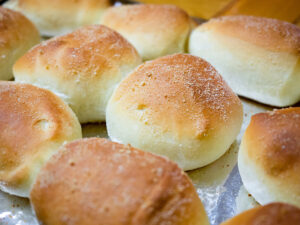The Philippines
Wheat market overview

While the Philippines doesn’t officially have a national bread, if it did, it would be pandesal. A soft and airy flour roll, pandesal is Spanish for “salt bread” and is a common breakfast bread of choice throughout the Philippines. However, contrary to its name, the bread is relatively sweet to appeal to Filipino consumer preferences. Bread formulations include sugar content of around 17 percent, versus 4 percent in the U.S. Furthermore, the long-term trend of low consumption of noodles in the Philippines compared with other countries in Southeast Asia gives bread products higher priority when sourcing wheat in the Philippines. Both these factors give U.S. hard red spring wheat (HRS) an advantage over other suppliers, and the significant biscuit and cake markets carve a distinct niche for U.S. soft white wheat (SW).
After several years of consumption shifting from wheat to rice, the trend is now moving the other way. In the past decade, annual rice consumption has fallen slightly, while wheat food consumption is up 51 percent. In the past five years, per capita consumption of milling wheat has risen from 26 kg to 36 kg. Although Philippine rice consumption is nearly four times greater than wheat, per capita consumption growth for wheat is moving at a rapid pace.
The Philippine Society of Baking estimates that there are more than 35,000 bakeries operating in the Philippines, mostly small-size operations with minimal mechanization. Fewer than 100 bakeries are fully or semi-mechanized. Large volume bakeries, especially those in metro Manila, have expanded their market share to other parts of the country by producing high-quality baked products that provide consumers value for money. With this expansion comes the requirement for the milling industry to maintain consistent, high-quality flours that are suitable for production line operations.
The Philippines does not produce wheat and therefore depends on imported wheat to meet its growing demand. Given the quality characteristics needed to make products that fit the Filipino diet, the U.S. enjoys more than 90 percent market share for milling wheat in the Philippines.
Market outlook for 2022-23
The Philippines is now the largest U.S. export market for both HRS and SW with high growth potential because of its dynamic economy, growing middle class and strong consumer demand. End-product preferences in the Philippines have facilitated a strong disposition for U.S.-origin wheat, and according to a 2020 study, millers, bakers and consumers in the Philippines credit USW programs and activities, which the Washington Grain Commission has been heavily involved in, with contributing to nearly 40 percent of the increase in per capita wheat consumption since 2014.
Despite strong economic growth forecasts for 2022, inflation remains a concern in the Philippines. High prices of wheat in the global markets continue to pull prices of flour and end-products higher. A presidential election in May will shift policy strategies for economic recovery as the country emerges from the COVID-19 pandemic, but the gradual economic reopening has helped revive household consumption, which will continue into the next marketing year.
USW maintains a world-class technical team to help improve end-use quality and consistency for medium to large baking and processing industries. Their technical programs help end-use manufacturers improve their ability to specify and obtain flour that consistently meets production requirements and supports expansion.
A market development success story
Until a decade ago, the Philippines was a consistent buyer of Western White wheat to use in their sponge and chiffon cakes. Western White is a blend of SW and at least 10 percent club wheat. The typical Philippine tender was 13 percent. However, high price premiums on club wheat caused Filipino mills to look at other formulations for their cake flour.
One mill, Philippine Foremost Milling Company (PFMC), saw opportunities after participating in USW-sponsored seminars and demonstrations of Japanese and Korean end-products that require a blend of Western White to achieve the desired quality. Washington Grain Commission funded an end-product collaborative study at the Wheat Marketing Center in Portland, Ore., with PFMC and other top mills in the country that analyzed the optimal Western White blend levels in Philippine and Japanese-style cakes.
Further technical servicing with USW technicians in 2021 gave PFMC the tools to launch their new unchlorinated cake flour, which led to the first Western White commercial shipment to the Philippines since marketing year 2012-13.
On the street
A note from Philippine Foremost Milling
"As one of the participants of the END Collaborative Study in Portland, Ore., U.S.A, Miss Jo Louise Sauler was able to grasp the technical aspect of the wheat that was evaluated, specifically the Western White, soft red winter wheat and soft white wheat, in terms of the requirements for its possible use. On the same year, we have a project for the removal or an alternative to chlorine treatment for cake flour, which the learning and experience was capitalized.
We have purchased a limited amount of Western White to verify the performance. In our study, we stumbled upon a series of challenges and questions where the assistance of the technical staff of U.S. Wheat Associates was helpful, especially the expertise of Mr. Roy Chung in baking applications and Mr. Peter Lloyd in milling, all made possible with the coordination and assistance of Mr. Gerry Mendoza and Mr. Adrian Redondo.
At the end, we were able to produce the unchlorinated cake flour using soft white, but chemical treatment is still preferred by the bakers. It will need time for the end-user to shift to the alternative. Hence, we are promoting the flour in a retail online selling platform. Eventually, the goal is for its use as a bulk commodity."—Roc Cañares, R&D Head, Philippine Foremost Milling
The Washington Grain Commission (WGC) promotes the small grains industry through the allocation of farmer checkoff dollars in the areas of research, market development and education. When it comes to promoting our wheat in international markets, the WGC works directly with U.S. Wheat Associates (USW), which is the export market development organization for the U.S. wheat industry. USW activities in more than 100 countries are made possible through grower contributions from 17 state wheat commissions (including Washington) and cost-share funding provided by the U.S. Department of Agriculture’s Foreign Agricultural Service. This Wheat Life series features some examples of how your commission checkoff dollars are working hard to promo te, grow and maintain demand for the high-quality U.S. wheat the world has come to rely on.
This article originally appeared in the April 2022 issue of Wheat Life Magazine.

USW South Asia
Joe Bippert is the assistant regional director for the U.S. Wheat Associates South Asia office in Manila.

USW Philippines
Adrian "Ady" Redondo is a baking technician for U.S. Wheat Associates based in Manila.

USW Philippines
Gerardo "Gerry" Mendoza is a baking consultant for U.S. Wheat Associates based in Manila.
